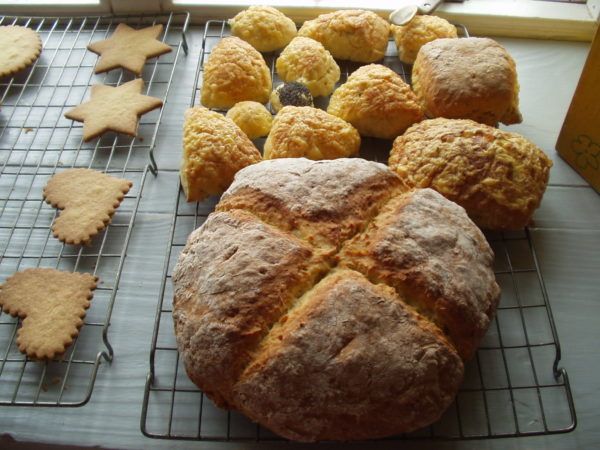The Perfect Loaf
In search of the perfect loaf of my ancestral Irish soda bread.

Trying to regain knowledge lost. A personal quest to retrieve lost heritage. These phrases describe the forces directing my search for the perfect loaf of Irish soda bread. Several years ago my husband and I visited Ireland where we stayed in numerous bed and breakfasts–B&Bs. Morning after morning, we were served a traditional Irish breakfast that included steaming hot tea, fresh squeezed orange juice, and a generous helping of freshly baked Irish soda bread smothered with butter and jam. The bread at each B&B was different, but all were delightful.
This experience was the beginning of a primal awakening. As I am of Irish descent on my father’s side, the flavors and textures united to stir in me the realization of ancestral knowledge, not quite remembered. Thus began my quest to find the perfect loaf of Irish soda bread. I obtained a couple of recipes from the owners of various B&Bs, but the measurements were in pounds, not cups, and given from memory, nothing like the recipes in most American cookbooks. Upon arriving home, I tried to re-create the wonderful breads I’d inhaled in Ireland, only to bring forth miserable imitations.
My search was not facilitated, to any great extent, by cookbooks readily available in America. Most of the standard cookbooks contain one, maybe two, very ordinary soda bread recipes. When I say “ordinary,” I mean that the recipes prescribed the most basic ingredients–flour, baking soda, and buttermilk.
Frustrated, I started hunting down more recipes. I first resorted to faxing hotels and B&Bs listed in tourist brochures. While the response ratio was not fantastic (due to the fact, I think, that some people guard their soda bread recipes like state secrets), I did receive some great recipes. But on return trips to Ireland, I have been more attentive and have not been afraid to ask for a recipe.
It would be hard to pick a favorite, though I have one. I suggest you enjoy them all with your favorite jam and forgo any diet just long enough to allow yourself some real butter. Some people, however, are of the opinion that these breads are unusually delicious, and perhaps more purely experienced, without butter or condiments of any kind.
ONLY THE BEST
The ingredients you need to make Irish soda bread are sometimes hard to come by. I’ve heard stories of people hauling pounds of Irish flour back to America in order to make bread, but that is really not practical in the long run. What do you do when your stash of “good” flour dwindles? You look for the best-quality substitutes you can find.
In their original form, Irish soda bread recipes call for flours like Odlum’s Coarse Ground Whole Meal, wheaten meal, or stone-ground whole meal flour. What all these flours have in common is that the wheat is crushed between millstones, producing flour with the texture of coarse sand and with the bran intact. Unfortunately, these flours, so pleasant to the palate and friendly to the digestive system, are not available on this side of the Great Pond.
After trying many American flours, the only type I can recommend is a better-quality stone ground whole wheat bread or pastry flour, which you can find in a good health food store. If the recipe calls for white flour, use an unbleached, unbromated flour like King Arthur.
Another fundamental ingredient for soda bread is buttermilk, which is a modern-day substitute for sour milk. Lacking eggs and yeast, buttermilk and baking soda are the agents that make soda bread rise. Fortunately, buttermilk is readily available in America. However, choose a good one. I use unhomogenized buttermilk from a chemical-free dairy in Pennsylvania, which even comes in a returnable glass bottle. Look for your own local source of back-to-the-basics milk, remembering that, like flours, milk products are not as adulterated in Ireland as they are here.
In regard to buttermilk, always be prepared to add or withhold a little from the recipe. Flours vary in their ability to absorb moisture, so more or less buttermilk will be needed, depending on the flour’s consistency and the day’s humidity.
DISTINCTLY IRISH
I’ve yet to come up with a scholarly reason why Irish soda bread is considered the definitive Irish bread. Traditionally, there are many types of breads in Ireland, including those leavened with yeast.
Maybe it has to do with the weather. Ireland, which is damp and cool most of the year, was probably not the best place for yeast to multiply–especially several hundred years ago, before modern heating systems in the home and convenience-packaged yeast strains were available. But it bread’s simplicity. A few ingredients are quickly mixed together, and, because no time is needed for the batter to rise, it can immediately be placed in the oven. What an easy way to bring fresh home-backed bread to the table every day!
In the past, an Irish woman’s claim to good housewifery rested on her ability to make a good loaf of soda bread. While that is not as true as it once was (mostly because of the advent of town bakeries), it is still a much-appreciated art, so much so that many restaurants have a resident soda bread baker on staff. Likewise, I’m sure there is not a B&B in the land that doesn’t provide its guests with freshly baked soda bread with their breakfasts.
Ideally, a fresh loaf of soda bread is baked everyday or couple of days. Before each loaf is placed in the oven, it is the custom to make a cross in the middle of the loaf with a knife. The gash should not be too deep, about one half inch. I have heard a couple of reasons for this custom, one spiritual and one practical. Some say it is a blessing to ensure that the bread turns out successfully. Others say it prevents the crust from cracking irregularly. No matter what the reason, adding a cross before baking yields a handsome loaf.
An additional key to a perfect loaf is a proper cooking time, which will probably have to be adjusted from over to over. Don’t lament if your first loaf with a new recipe is under-or overdone. Just try again. And besides, despite deficiencies, the loaf will probably still be edible.
After cooling, it is recommended that the loaf be stored in a damp tea towel to keep it moist. Some say that this should be done immediately after the loaf comes out of the over, but I prefer to wait until the loaf has cooled for about four hours.
There is one last point. You must buy a scale to weigh the flour for the recipes accompanying this article. There is just no way around it. Flours vary so dramatically that any attempt to create a multiplication table for the conversion of pound measurements to cups will be inaccurate. You don’t need to spend $100 for a good scale. I found a perfectly usable scale for under $20 at a gourmet kitchen store. You will find that the recipes come out much more consistently when you weigh the flour.
Remember that breads turn out slightly different for each person who makes them. Be encouraged, as I have been, in your own quest to bring good bread to your table. Perhaps I’ll never know the exact bread my ancestors baked on the hearth or longed for after leaving Ireland, but my search for the perfect loaf has been cathartic and liberating, and the results of my search will grace my family’s table for years to come.
Muesli Soda Bread
In honor of St. Patrick’s Day, I am sharing with you one of most prized, heretofore secret, recipes. About ten years ago, I met a woman on a flight back to the United States from Ireland. We chatted about Irish soda bread, and she recited one of her favorite recipes from memory. Made with muesli, it has become one of my favorites, too. I use Bob’s Red Mill muesli. If you are lucky enough to have a source of raw milk, measure out the required amount and set it in a warm place overnight to sour. The reason you need to sour the milk is to produce enough lactic acid to react with the alkaline baking soda, which produces carbon dioxide gas to raise the bread.
- 3 cups spelt flour, sprouted spelt flour, or 2¾ cups whole wheat flour
- 2 cups muesli
- 1 tsp. baking soda
- ¼ cup butter
- 1 egg
- 1½ cups buttermilk, soured raw milk, or yogurt
Measure out the flour, muesli, and baking soda in a medium-to-large bowl. Cut the butter into small pieces and then pinch them into smaller pieces working them into the flour with your fingers until you obtain a grainy texture. Add the egg to the buttermilk and lightly beat to incorporate. Pour the milk/egg mixture into the dry ingredients and mix to make a thick, yet moist, dough. Be ready to add a little more buttermilk, soured milk, or yogurt if necessary.
Turn the dough out on a floured piece of parchment paper and shape into a round loaf. Move the loaf to a parchment-lined baking sheet and cut a cross in the top of the dough. Bake at 375ºF for 1 hour, or until a toothpick comes out clean. Cool overnight and serve for breakfast with lots of butter and jam.


